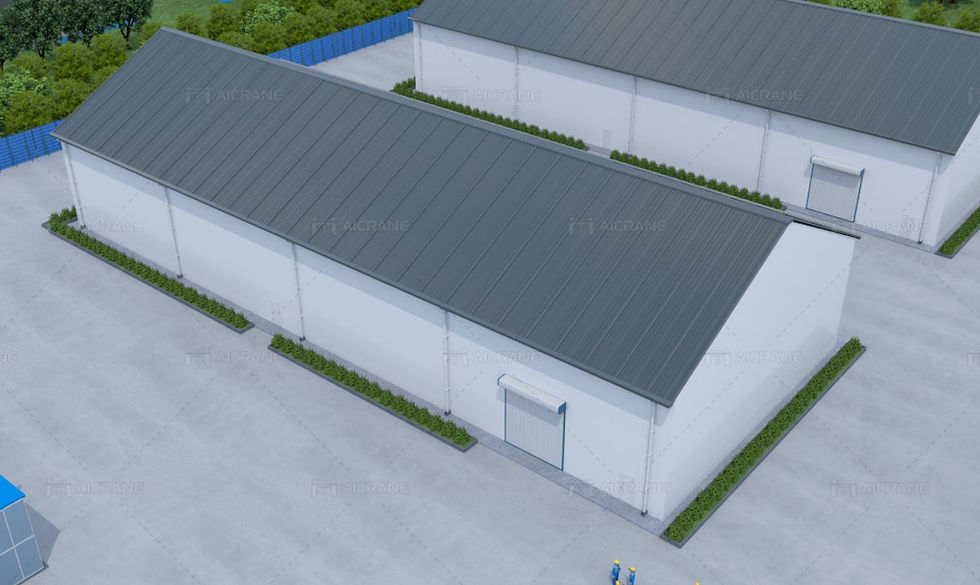A Guide to Steel Structure Hangar Maintenance
- blog@ellsenbridgecrane.com
- Jan 22, 2024
- 3 min read
Steel structure hangars serve a critical role in aviation, providing shelter and protection for aircraft. To ensure the longevity, safety, and optimal performance of these structures, a well-defined maintenance plan is essential. In this article, we will explore the various aspects of maintenance required for steel structure hangars, highlighting key considerations and best practices.

Regular Inspections:
Regular inspections are the cornerstone of effective maintenance for steel structure hangars. Inspections should be conducted at scheduled intervals to assess the overall condition of the structure. This includes checking for signs of corrosion, structural damage, and wear and tear. Early detection of issues allows for prompt intervention and prevents small problems from escalating.
Corrosion Prevention and Treatment:
Corrosion is a common concern for steel structures, especially in hangars located in areas with high humidity or proximity to saltwater. Implementing corrosion prevention measures, such as protective coatings and sealants, is crucial. Regularly inspecting for signs of corrosion and promptly treating affected areas with anti-corrosive solutions ensures the structural integrity of the hangar.
Roof Maintenance:
The roof is a critical component of a hangar, providing protection against weather elements. Regular roof inspections should be performed to check for leaks, loose fasteners, or damaged roofing materials. Cleaning gutters and drainage systems is also essential to prevent water accumulation, which can lead to structural damage and compromise the hangar's integrity.
Door Systems Maintenance:
Hangar doors play a pivotal role in facilitating the entry and exit of aircraft. Regular maintenance of door systems is essential to ensure smooth operation. This includes inspecting door tracks, lubricating moving parts, and checking for any misalignments. Addressing issues promptly avoids disruptions in aircraft operations.
Lighting and Electrical Systems:
Proper lighting is crucial for hangar operations, especially during aircraft maintenance and inspections. Regularly inspecting and maintaining lighting systems ensures a well-lit and safe environment. Additionally, electrical systems, including power outlets and backup generators, should be inspected to prevent electrical failures.
HVAC Systems:
Hangars often house sensitive equipment and aircraft that require controlled temperatures. Regular maintenance of heating, ventilation, and air conditioning (HVAC) systems is essential to ensure consistent and efficient climate control. This includes cleaning filters, checking ductwork, and inspecting for any signs of malfunction.
Surface Maintenance:
The external surfaces of a steel structure hangar, including walls and cladding, should be regularly cleaned and inspected. This helps prevent the buildup of dirt, pollutants, and corrosive substances. Power washing or using appropriate cleaning solutions can help maintain the aesthetic appeal and structural integrity of the metal hangar structure.
Fire Protection Systems:
Hangars need robust fire protection systems to safeguard against potential fire hazards. Regular checks of fire suppression systems, including sprinklers and extinguishers, should be conducted to ensure they are in working order. Emergency exit routes and signage should also be inspected for visibility and accessibility.
Pest Control:
Hangars are susceptible to pest infestations, which can compromise the structural integrity of the building. Implementing pest control measures and conducting regular inspections to identify and address pest issues are essential for maintaining a hygienic and safe environment.
Documentation and Record-Keeping:
Maintaining comprehensive documentation of all maintenance activities is crucial for accountability and future planning. Keep records of inspections, repairs, and any upgrades performed. This documentation serves as a valuable resource for tracking the history of maintenance and predicting future needs.
Conclusion:
In conclusion, the maintenance of a steel structure hangar is a multifaceted task that requires a proactive and systematic approach. Regular inspections, corrosion prevention, roof maintenance, and attention to various systems ensure the hangar's longevity and functionality. By implementing a comprehensive maintenance plan and addressing issues promptly, operators can ensure the safety of aircraft, protect valuable assets, and extend the lifespan of their steel structure hangars.








Welcome to Kelvin Mech – a leading name in heating, ventilation, and air conditioning solutions across the country. With a strong presence as an established HVAC contractor in Mumbai, Delhi, and Pune, we specialize in offering customized HVAC design, installation, and maintenance services for commercial, industrial, and residential projects.